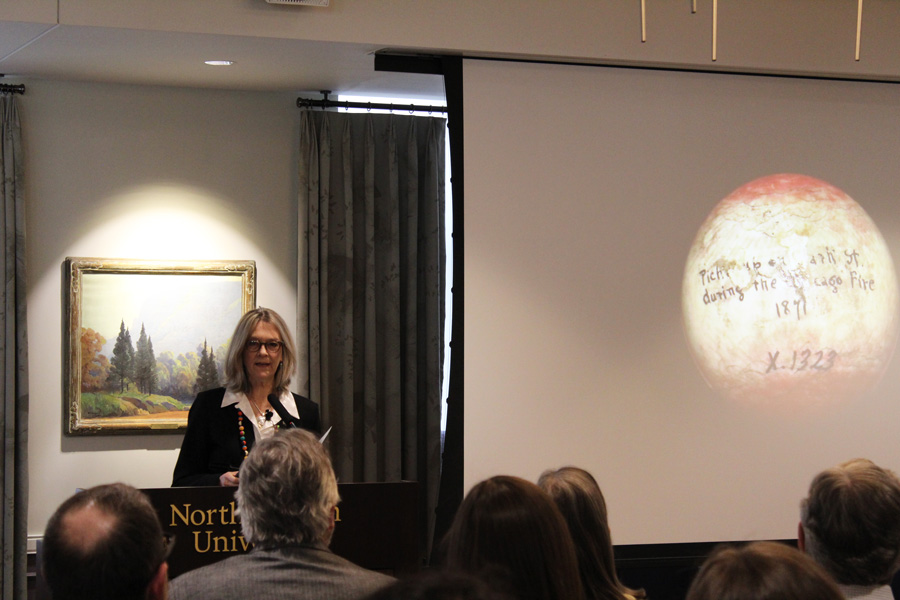South African artist, academic discusses work at Buffett Institute talk
Linnea Narducci/The Daily Northwestern
Visiting Prof. Pippa Skotnes speaks Monday in Scott Hall. Skotnes used a charred billiards ball from the Great Chicago Fire to explain her archival research on the San peoples.
May 9, 2017
South African artist and academic Pippa Skotnes used animal bones as a canvas to narrate the stories of the San peoples of South Africa.
Skotnes said the combination of the bones — which came from two giraffes that starved to death after being neglected in a sanctuary in South Africa — and the stories of indigenous people who were massacred represented the themes of pain and sacrifice.
Skotnes, who is visiting NU for Spring Quarter as the Roberta Buffett Professor of International Studies, spoke about her work with art and archives to around 50 people in Scott Hall on Monday. The event was hosted by the Buffett Institute for Global Studies. Skotnes’ research is focused on an archive compiled by Wilhelm Bleek and Lucy Lloyd. The archive is a record the history and culture of southern Africa’s indigenous peoples.
Skotnes’ interest in anthropology broadens the traditional idea of international studies, said Bruce Carruthers, director of the Buffett Institute.
“When someone like me thinks about globalization, I am thinking about the economy and politics and security, and I’m not really so much in the realm of the arts, or culture,” Carruthers told The Daily. “But I knew that the issues that she was dealing with represented a new side of what is global.”
Skotnes recorded the letters of Louis Anthing, magistrate of Namaqualand in the 19th century who studied atrocities committed against the San, by carving them into the giraffe bones. She said the letters are an account of the massacre of San people by “commando and trekboers” in southern Africa.
Skotnes spoke about a visit she made to the Chicago History Museum, where a burnt billiards ball caught her attention. She compared the billiards ball — which is a remnant from the Great Chicago Fire of 1871 — to her studies about the San people.
“(It is) an invitation to think about destruction and survival and one object’s individual journey from the past into the present,” Skotnes said.
The Bleek and Lloyd archive is a compilation of stories and personal histories, Skotnes said. It created a dictionary of the San people’s language, called ǀXam, which is no longer spoken, she said.
Skotnes is teaching a class at NU focused on the Bleek and Lloyd archive.
Weinberg sophomore Ellery Stritzinger, who is in Skotnes’ class and attended the event, said she loved the subjects Skotnes introduces to the class because they are all new to her. Stritzinger said Skotnes has played an important role in publicizing the archive.
“She is the one that brought (the archive) to the public eye back in the 90s, so had she not been involved with it, no one anywhere would have really been involved with it,” Stritzinger said.
Email: [email protected]
Twitter: @juliaesparza10


